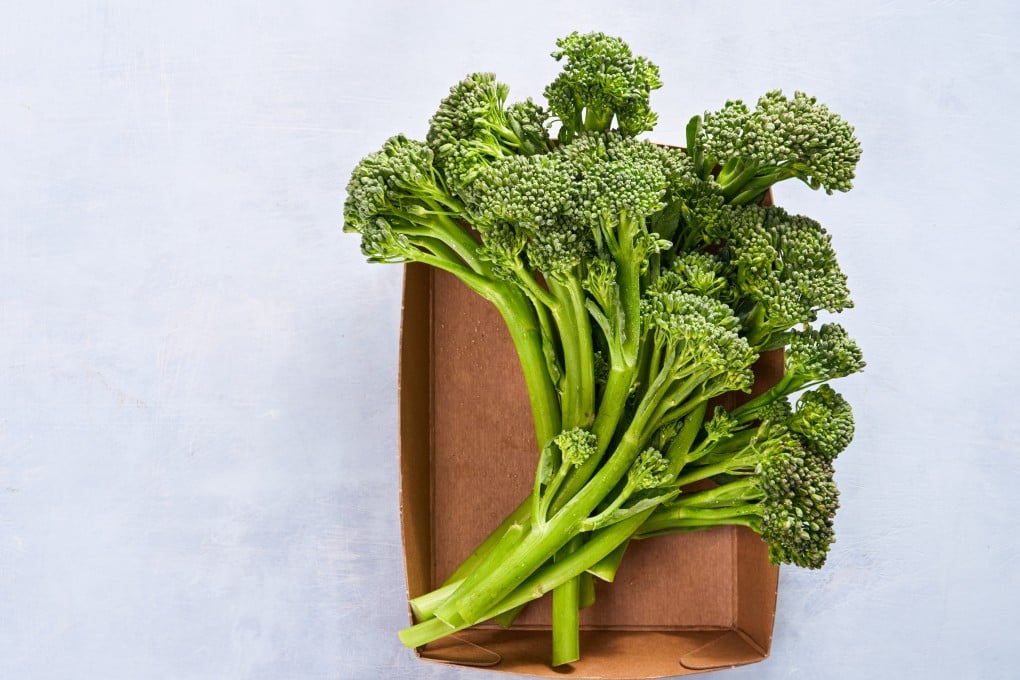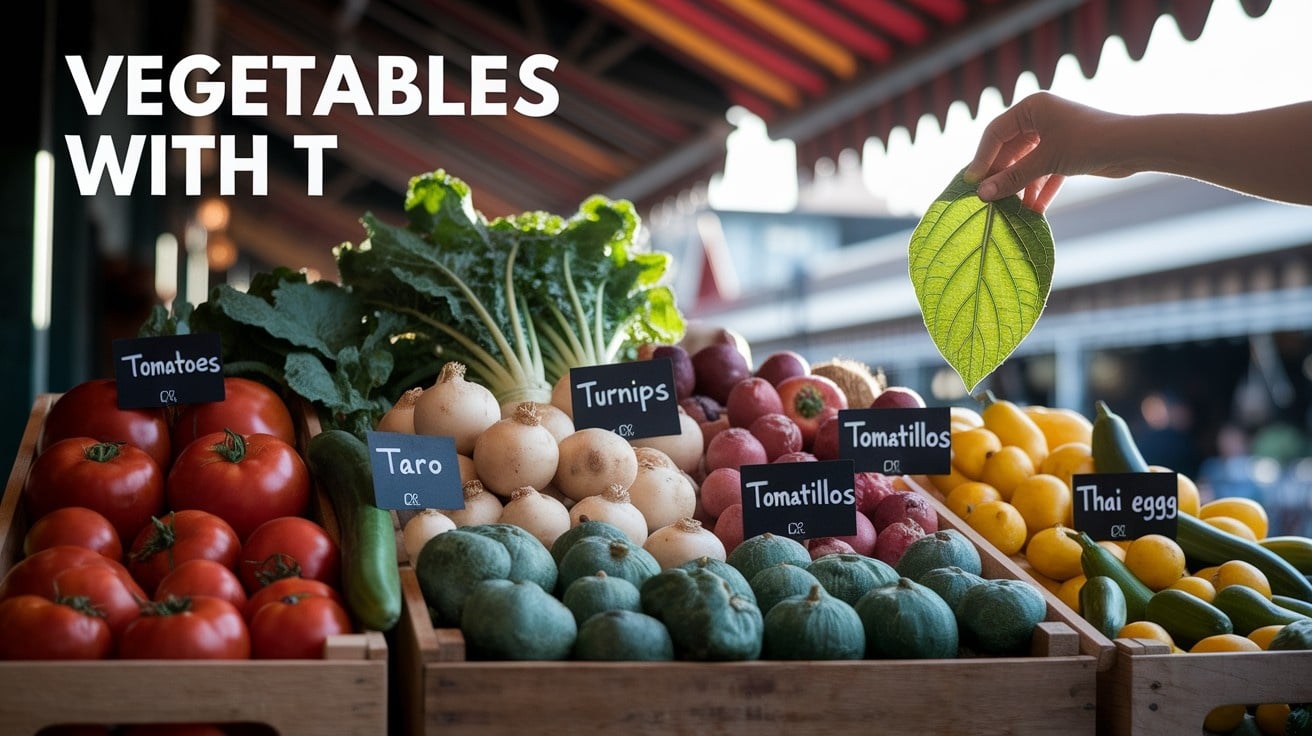
From the familiar tomato to the exotic Tamarillo, the set below opens a window to botanical diversity that many home cooks never experience.
This detailed overview showcases numerous T-named vegetables, detailing their origins from the Andes to Southeast Asia, nutritional profiles rich in everything from lycopene to curcumin, and culinary applications spanning cultures worldwide.
Did you know that several vegetables begin with the letter T, each offering unique flavors and health benefits from around the world?
Suppose you’re looking to improve your diet with Thai basil’s aromatic complexity or experiment with tindora in traditional curry preparations. In that case, each entry provides practical storage advice to maximize freshness and flavor.
Join this trip through the lesser-known corners of the plant kingdom and learn how these distinctive vegetables can change your cooking with new textures, tastes, and traditions.
Popular Vegetables Starting with “T”
1. Tomato

Origin: Native to western South America and Central America
Nutritional benefits: Rich in vitamin C, potassium, and antioxidants like lycopene
Culinary pairings: Pairs well with basil, garlic, olive oil, and cheese
Storage tips: Store at room temperature; avoid refrigeration to maintain flavor
2. Taro
Origin: Indigenous to Southeast Asia and India
Nutritional benefits: High in fiber, vitamin E, and resistant starch for gut health
Culinary pairings: Used in soups, stews and mashed with coconut milk
Storage tips: Store in a cool, dry place away from sunlight
3. Turnip
Origin: Likely originated in Europe or Central Asia
Nutritional benefits: Good source of vitamin C, fiber, and folate
Culinary pairings: Roasted with honey, mashed with potatoes, or added to soups
Storage tips: Store in the refrigerator, wrapped in a damp cloth
4. Tomatillo
Origin: Native to Mexico and Central America
Nutritional benefits: High in vitamin C and fiber, low in calories
Culinary pairings: Used in salsa verde, tacos, and roasted dishes
Storage tips: Keep husks on and store in a paper bag in the fridge
5. Tigernut (technically a tuber vegetable)
Origin: Native to Africa and the Mediterranean
Nutritional benefits: High in fiber, iron, and healthy fats
Culinary pairings: Used in smoothies, dairy-free milk, and energy bars
Storage tips: Store in a cool, dry place in an airtight container
6. Thai eggplant
Origin: Native to Southeast Asia
Nutritional benefits: Low in calories, rich in fiber and antioxidants
Culinary pairings: Common in Thai curries, stir-fries, and pickles
Storage tips: Keep in a cool, dry place or refrigerate in a perforated bag
7. Tree onion
Origin: Believed to have originated in Asia or Europe
Nutritional benefits: High in vitamin C, antioxidants, and sulfur compounds
Culinary pairings: Used in salads, pickles, and stir-fries
Storage tips: Store in a dry, well-ventilated place
8. Tepary bean
Origin: Indigenous to the southwestern United States and Mexico
Nutritional benefits: High in protein, fiber, and essential minerals
Culinary pairings: Ideal for soups, stews, and refried bean dishes
Storage tips: Store dried beans in an airtight container in a cool place
9. Tokyo turnip
Origin: Japan
Nutritional benefits: Rich in vitamin C, fiber, and potassium
Culinary pairings: Enjoyed raw in salads, roasted, or pickled
Storage tips: Store in the fridge, wrapped in a damp paper towel
10. Tiquisque (a tropical root vegetable)
Origin: Native to Central and South America
Nutritional benefits: Provides fiber, potassium, and complex carbohydrates
Culinary pairings: Used in stews, soups, and mashed dishes
Storage tips: Keep in a cool, dark, and dry place
11. Turkish rocket
Origin: Native to Eastern Europe and Asia
Nutritional benefits: High in vitamins A and C and contains beneficial phytonutrients.
Culinary pairings: Used in salads, stir-fries, and as a cooked green
Storage tips: Refrigerate wrapped in a damp paper towel
12. Torpedo onion
Origin: Italy
Nutritional benefits: Rich in vitamin C and antioxidants
Culinary pairings: Used in salads, roasted dishes, and caramelized for toppings
Storage tips: Store in a cool, dry place with good air circulation
13. Tindora (ivy gourd)
Origin: South and Southeast Asia
Nutritional benefits: Good source of vitamin C, fiber, and iron
Culinary pairings: Used in curries, stir-fries, and pickles
Storage tips: Refrigerate in a breathable bag for freshness
14. Tatsoi
Origin: East Asia, particularly China and Japan
Nutritional benefits: High in vitamins A, C, and K, and antioxidants
Culinary pairings: Used in salads, soups, and stir-fries
Storage tips: Store in the fridge, wrapped in a damp cloth
15. Tiger lily bulbs
Origin: Native to East Asia
Nutritional benefits: Rich in starch, vitamin C, and antioxidants
Culinary pairings: Used in soups, stir-fries, and herbal medicine
Storage tips: Store in a cool, dry place; refrigerate if fresh
16. Thai basil
Origin: Southeast Asia, especially Thailand and Vietnam
Nutritional benefits: Contains vitamin K, antioxidants, and essential oils
Culinary pairings: Used in Thai curries, pho, and stir-fries
Storage tips: Store fresh in water like cut flowers or refrigerate
17. Tulsi (holy basil)
Origin: Native to India
Nutritional benefits: Rich in antioxidants, reduces stress, and supports immunity
Culinary pairings: Used in teas, herbal remedies, and Indian cuisine
Storage tips: Keep in the fridge wrapped in a damp paper towel
18. Trendy greens
Origin: Varies, typically cultivated as specialty greens
Nutritional benefits: High in vitamins A and C, fiber, and antioxidants
Culinary pairings: Used in salads, smoothies, and stir-fries
Storage tips: Refrigerate in a perforated bag
19. Tronchuda kale
Origin: Portugal
Nutritional benefits: High in vitamin C, fiber, and antioxidants
Culinary pairings: Used in soups, stews, and sautéed dishes
Storage tips: Refrigerate in a breathable bag to retain moisture
More Vegetables that Start with “T”
20. Tree spinach
Origin: Native to Mexico and Central America
Nutritional benefits: High in iron, calcium, and antioxidants
Culinary pairings: Used in soups, stews, and stir-fries
Storage tips: Store fresh leaves in the refrigerator in a damp paper towel
21. Truffle (culinary fungi used as a vegetable)
Origin: Europe, especially France and Italy
Nutritional benefits: Rich in antioxidants and contains antibacterial properties
Culinary pairings: Pairs well with pasta, eggs, cheese, and butter-based sauces
Storage tips: Store in a paper bag in the fridge and use within a few days
22. Turnip greens
Origin: Widely cultivated in Europe and Asia
Nutritional benefits: High in vitamins A, C, and K, plus fiber
Culinary pairings: Used in sautés, soups, and stews
Storage tips: Refrigerate in a plastic bag with some moisture
23. Tong ho (edible chrysanthemum)
Origin: East Asia, particularly China and Japan
Nutritional benefits: High in vitamin A, antioxidants, and fiber
Culinary pairings: Used in hot pots, stir-fries, and soups
Storage tips: Store in the fridge, wrapped in a damp paper towel
24. Tannia (similar to taro)
Origin: Native to Central and South America
Nutritional benefits: Rich in fiber, carbohydrates, and minerals like potassium
Culinary pairings: Used in stews, mashed dishes, and fried preparations
Storage tips: Keep in a cool, dark, dry place
25. Texsel greens
Origin: Developed from Ethiopian mustard, popular in Europe
Nutritional benefits: High in vitamins C and K, and beneficial plant compounds
Culinary pairings: Used in salads, sautés, and green smoothies
Storage tips: Store in a perforated bag in the fridge
26. Thai garlic
Origin: Native to Southeast Asia
Nutritional benefits: Contains allicin, which supports heart health and immunity
Culinary pairings: Common in Thai curries, stir-fries, and sauces
Storage tips: Store in a dry, ventilated area away from moisture
27. Tuber mustard
Origin: China
Nutritional benefits: Rich in fiber, vitamin C, and antioxidants
Culinary pairings: Used in pickled dishes, stir-fries, and soups
Storage tips: Store in the refrigerator in a breathable bag
28. Tayberry leaves (edible greens)
Origin: Hybrid between a raspberry and blackberry, developed in Scotland
Nutritional benefits: High in antioxidants and vitamin C
Culinary pairings: Used in teas and salads
Storage tips: Refrigerate fresh leaves in an airtight container
29. Thistle (edible variety)
Origin: Native to Europe and the Mediterranean
Nutritional benefits: High in fiber and beneficial phytonutrients
Culinary pairings: Used in salads, soups, and herbal remedies
Storage tips: Keep fresh stems in water or refrigerate wrapped in a damp cloth
30. Tonka bean sprouts
Origin: South America
Nutritional benefits: Contains protein, fiber, and antioxidants
Culinary pairings: Used in gourmet dishes and desserts
Storage tips: Store in the fridge, wrapped in a damp paper towel
31. Tuberous chervil
Origin: Europe
Nutritional benefits: Rich in fiber, vitamin C, and beneficial plant compounds
Culinary pairings: Used in soups, stews, and roasted dishes
Storage tips: Store in a cool, dry place, away from moisture
32. Turmeric leaf
Origin: South and Southeast Asia
Nutritional benefits: Contains antioxidants and anti-inflammatory properties
Culinary pairings: Used in curries, rice dishes, and herbal teas
Storage tips: Keep fresh leaves in the refrigerator or dry them for longer storage
33. True yam
Origin: West Africa and Asia
Nutritional benefits: High in fiber, potassium, and vitamin C
Culinary pairings: Used in stews, mashed, or fried
Storage tips: Store in a cool, dry place away from direct sunlight
34. Taiwanese cabbage
Origin: Taiwan
Nutritional benefits: High in vitamin C and fiber, supports digestion
Culinary pairings: Used in stir-fries, soups, and braised dishes
Storage tips: Refrigerate in a crisper drawer for freshness
35. Tossa jute (a leafy vegetable)
Origin: Native to Africa and South Asia
Nutritional benefits: High in fiber, vitamin A, and antioxidants
Culinary pairings: Used in soups, stews, and herbal medicine
Storage tips: Keep in the fridge, wrapped in a damp paper towel
36. Tarragon
Origin: Native to Eurasia, especially France and Russia
Nutritional benefits: Rich in antioxidants and supports digestion
Culinary pairings: Used in sauces, marinades, and herbal butters
Storage tips: Store fresh in a plastic bag in the fridge or dry for long-term use
37. Toona (Chinese mahogany vegetable)
Origin: Native to China and Southeast Asia
Nutritional benefits: High in vitamin C, fiber, and antioxidants
Culinary pairings: Used in stir-fries, dumplings, and soups
Storage tips: Keep fresh leaves refrigerated in a perforated bag
Wrapping It Up
Mother Nature’s T-section offers a bounty worth celebrating! Beyond the familiar tomato and turnip lie dozens of lesser-known treasures, such as tamarillo, tindora, and tatsoi.
These plants connect us to culinary traditions across continents—from the Andean highlands to Southeast Asian kitchens.
What stands out is the incredible health value packed into these foods. Rich in essential vitamins, minerals, and unique compounds that boost wellness, these vegetables represent nature’s pharmacy in its most delicious form.
Bringing these botanical gems into the kitchen, recognizing both health and the diverse food cultures that have loved them for generations. Happy growing and happy eating!
If you’re interested in more informative education & learning content, feel free to click here and explore other blogs that you might enjoy!

:max_bytes(150000):strip_icc()/GettyImages-669188030_-mygod_p-2000-9907453a12e245a8be97ad501d99b29a.jpg)


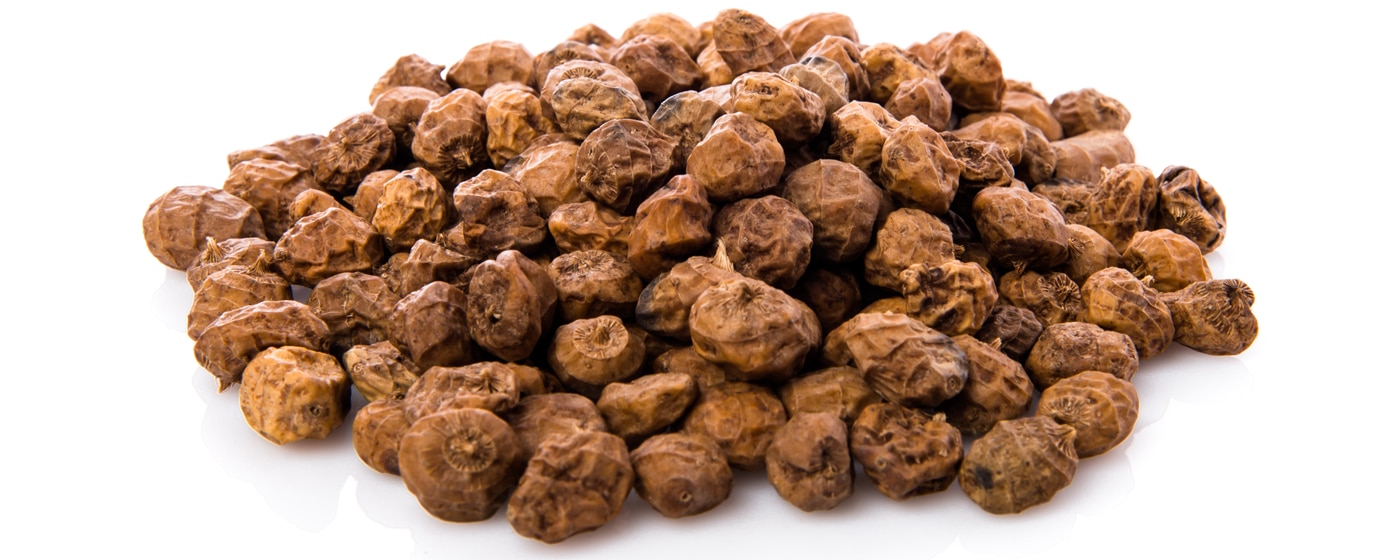

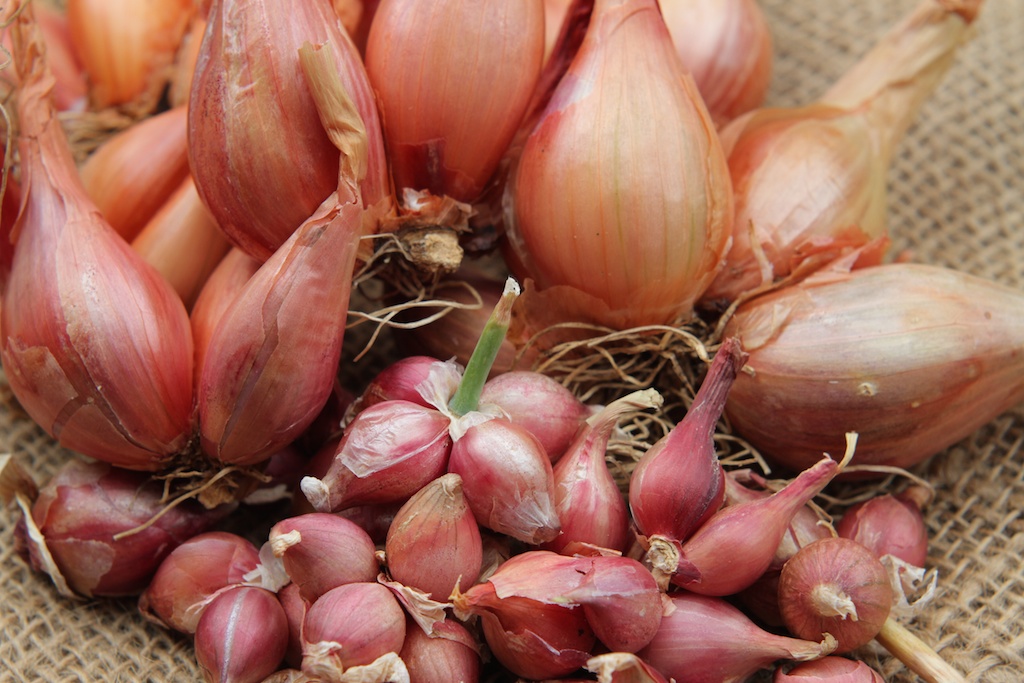


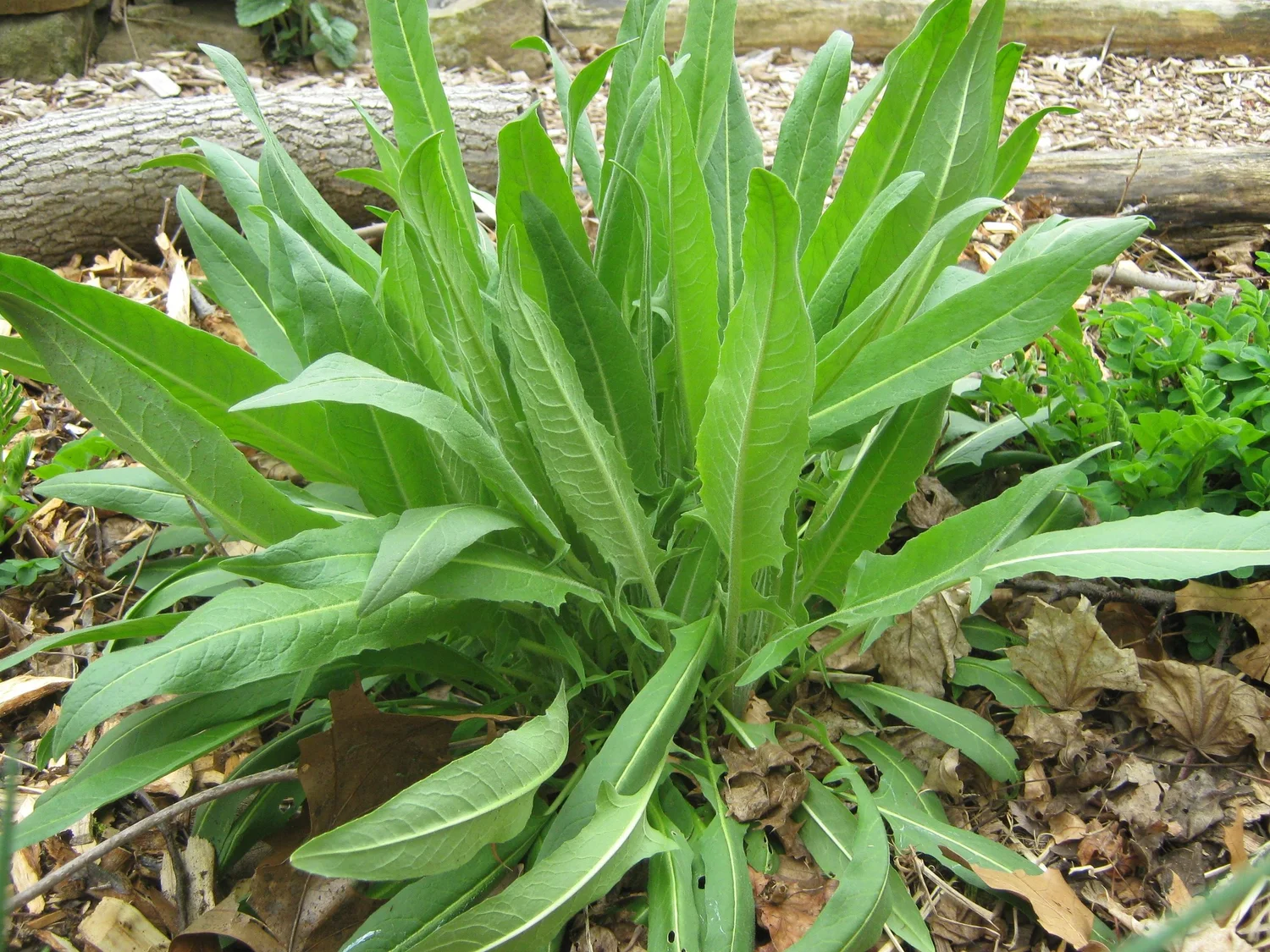




:max_bytes(150000):strip_icc()/thai-basil-7375163_03-e363e7db49204d128c04a22e8fb16a34.jpg)

